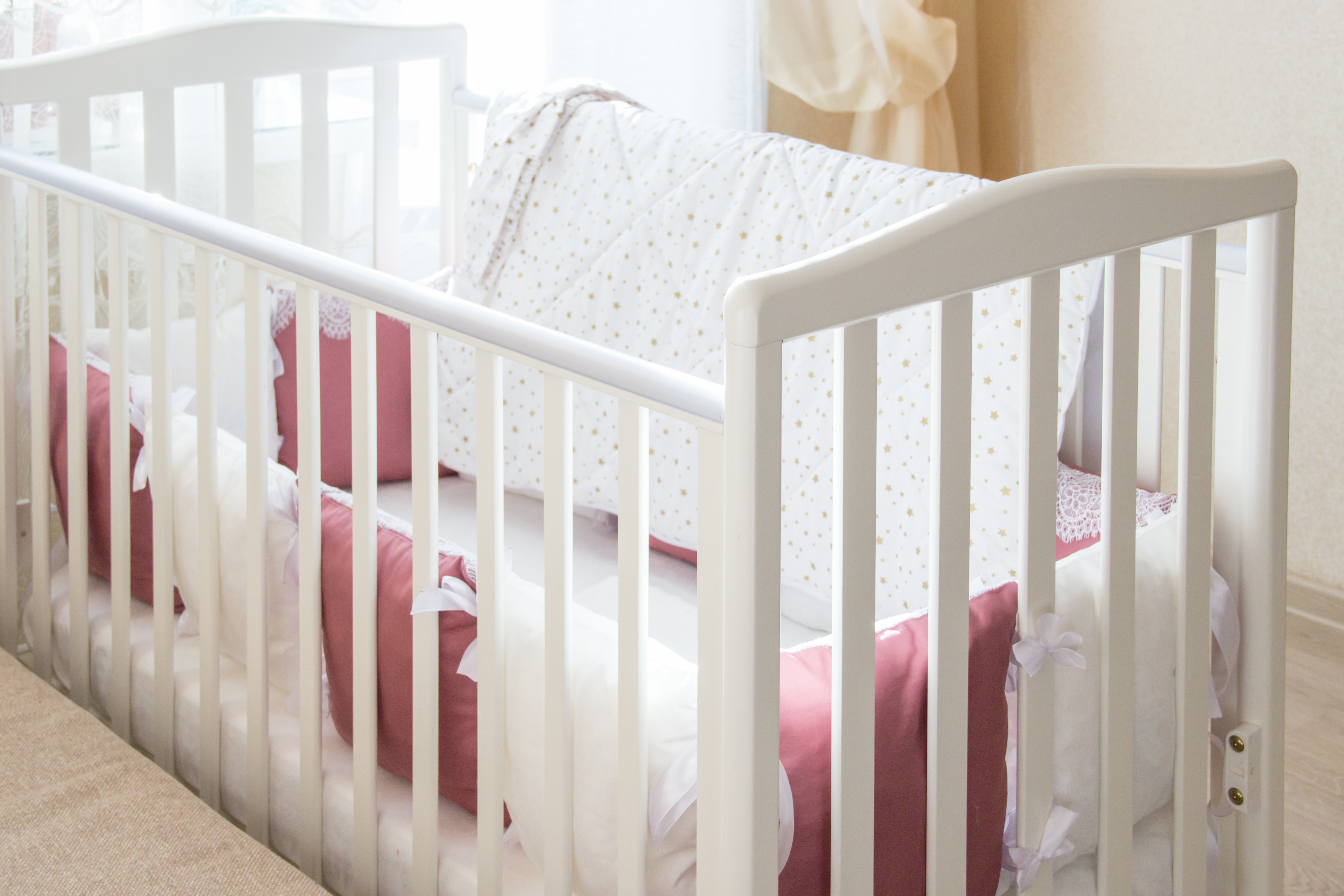Interested in learning about sleep training methods? In this article, we’re sharing a full overview of what sleep training is (and what it isn’t) plus talking about 5 of the most common sleep training methods to choose from.

This post comes to you from Lindsey McGonegal from Sleep Little Lamb! Lindsey is a certified baby and toddler sleep consultant and helped us sleep train our own daughter with fantastic results. Take it away Lindsey!
So, you’ve just survived another night of multiple wake-ups from your adorable baby. Not only did you spend 2 hours trying to get baby to sleep in the first place, you also had to repeat the same process over and over again throughout the night. You drag yourself out of bed in the morning, already exhausted before the day has even started. You thought by now your baby would naturally be sleeping better, but it only seems to be getting worse. You finally resolve that something has to change. It’s time to sleep train.
But deciding it is time to start and knowing how to start are two different things. Do you just shut the door and walk out? Or do you try the chair method? Or Ferber? Or wake to sleep? How do you know what will work best for your child?
Before we go over the most popular sleep training methods, let’s talk about WHY sleep training is sometimes necessary, what exactly it is and how to be successful with it.
Why is sleep training important?
Early on, many babies rely on their parents bouncing, rocking, and nursing them to get them to sleep for bedtime. While this can be great in the early months, babies often outgrow these methods and they stop working, meaning that it begins to take hours until the baby finally succumbs to exhaustion, only to wake up again shortly after. Also, just as we rely on sleep cues to fall asleep at night – our bed, darkness, maybe a certain pillow and white noise, our babies also develop sleep associations in order to fall asleep. Then when they naturally wake up at night as they change to a deeper or lighter sleep phase (which starts happening about twice as often once they hit the “4-month regression,” they will look for that same assistance to get them back to sleep again, over and over. That’s why we want them to learn to fall asleep independently initially, so that they don’t rely on the extra assistance all night long and can instead put themselves back to sleep independently.
What is sleep training?
Sleep training is the process of helping a baby learn to fall asleep independently. What method you choose is simply the response you will consistently use when your baby starts to struggle with this new skill, which they’ll usually express by crying. Instead of resorting back to your previous methods (nursing/rocking/bouncing/etc.) you choose to continue encouraging independent sleep and give your baby the opportunity to learn. Although it’s hard to watch our babies struggle, the struggle produces a beautiful new skill and ability to sleep like a champ. You will be so proud!
Which sleep training method is the best?
Successful sleep training has much more to it than just choosing a method. You need to have proper sleep hygiene including a good nap and bedtime routine, an age-appropriate daytime schedule for naps and feedings, sleep-supporting nutrition, a proper sleep environment, and realistic goals to aim for. You also need to check for any underlying medical issues that may be affecting their sleep. (These are all part of what we cover in Little Lamb’s 9-Step Sleep Solution). An overtired, under tired, hungry, or over-fed baby is not going to respond well. You may use one of the methods below perfectly, but still be left with a baby or toddler who is up multiple times a night, cries at bedtime, or fights their naps. If that’s the case, or if you want to do it right the first time without the guesswork, please contact us!
When most people hear “sleep training” they automatically think “cry it out” where you just shut the door and walk out. But the good news is, this is not the only way! There is a whole spectrum of sleep training methods, and it’s not just a one-size-fits-all approach. At Little Lamb, our strong conviction is that in order for a family to see success, we need to find a method of sleep training that best fits the family’s values, culture, beliefs, and the child’s age and individual temperament. Research supports this fact!
On one side of the spectrum, you have the slow methods that involve lots of parental presence and contact. On the other side is “cry it out”, or what is technically called Extinction. In between are a number of methods that involve giving your baby some space to learn, but that also let parents console their children and be present. Starting with the gradual methods and moving down to the faster ones, let’s go over some of my most popular sleep training methods.
Read the chart below and notice which you are most drawn to and what you think fits your family best.
Method #1: Pick-Up/Put-Down
- Best ages: 3-6 months
- Description: The child is put to bed tired but awake. When the child starts crying, the parents pick up and sooth until they are calm but not asleep, and puts them back down. Repeat until the child falls asleep in the crib. Increase intervals between pick-ups each night.
- Positive Aspects: The parent is always present, the baby is never left alone to cry, and it can be used on younger babies because the parent is physically assisting to calm.
- Drawbacks: High parental involvement can be exhausting for the parent and too stimulating for some babies. It can be hard for some parents to be consistent.
- Temperament: Works best for young babies and easy-going babies.
Method #2 – Gradual Withdrawal
- Best ages: 6+ months – preschool
- Description: The parent starts out laying next to the child’s bed. The parent lays there “sleeping” each night until the child falls asleep. Can use words and touch for the first few nights but gradually moves farther away from the bed every 1-3 nights until out of the room.
- Positive Aspects: Parent is always present, but gives a little more space than PU/PD. A fearful child feels supported. Great for transitioning away from co-sleeping.
- Drawbacks: May be too stimulating or frustrating for some children. May take longer than other methods. It can be harder for parents to consistently enforce boundaries.
- Temperament: Works best for easy-going and/or anxious kids.
Method #3 – Extinction with Parental Presence
- Best Ages: 4 months – 1.5 years
- Description: The child is put to bed tired but awake. A parent sits in the room visible to the child but verbal or physical contact is used. The parent leaves once the child is asleep but returns upon waking.
- Positive Aspects: Tends to work relatively quickly. The parent can observe the child and the child knows the parent hasn’t left them.
- Drawbacks: Too stimulating for some kids who may get frustrated that you’re there but not holding them. It can be very hard for parents to not give in.
- Temperament: Works best for more easy-going, sensitive children who benefit from supportive presence. Also good for parents who are opposed to leaving a crying child for any amount of time.
Method #4 – Check and Console
- Best ages: 4 – 24 months
- Description: The child is put to bed tired but awake, then the parent leaves the room but returns to check in on and console the child. The intervals of time between checks continue to increase until the child falls asleep without a parent present.
- Positive Aspects: Tends to work very quickly because it gives the baby space to learn, but you’re still able to check-in and reassure the baby.
- Drawbacks: Can feel like too much crying alone for some parents. It can also be too stimulating for some babies when parents keep popping in and out.
- Temperament: Works for most temperaments, but even for the most social, strong-willed child, it still may be too stimulating. For a sensitive baby, it may not be enough reassurance.
Method #5 – Extinction
- Best Ages: 6 months – 1.5 years
- Description: The child is put to bed tired but awake and the parent leaves the room. The parent does not go back in the room until scheduled feed or morning wake-up time.
- Positive Aspects: Tends to work very quickly. Easiest to be consistent. Clear communication for the child.
- Drawbacks: Might not be enough support for some kids, and parents may feel guilty about not being present. Parents are unable to see clearly if something happened.
- Temperament: Works best for very strong-willed, social children who need more space and for whom other methods haven’t worked. Also good for parents who are extremely exhausted and need fast change.

The 5 sleep training methods mentioned above are the framework for most other methods out there. We recommend choosing the sleep training method that you are most comfortable with, that fits your child’s personality most closely so that you can be consistent with it. You’ll want to try to stick with the method for at least a few days before abandoning it to give you and your child time to adjust and respond. If you have more questions, feel free to drop them in a comment below and stay tuned for future articles where we will be covering sleep training at every age, sleep training through regressions, and sleep training FAQs!
At Little Lamb, we customize an approach that fits each individual child in countless combinations of the above methods. If you would like help determining the best method for your family and support while implementing a holistic sleep plan, set up your free sleep call here.













I would add the Hold With Love method by Susan Urban (parental-love.com/baby-sleep-training) – There is described how to use the fourth trimester theory from the very first day of baby life and how it’s helpful in the future training
Trish thanks for the recommendation 🙂 I’m checking all the internet about the sleep training methods and at almost every site I can read bunch of positive comments about this Hold With Love method. I’m geting more and more confident about this one!
She’s the best one! I followed it two times now and twice with success! Pretty simple, easy to follow and – what’s most imporant – it is working!
It saddens me that in the modern-day loss of the parental “village,” babies are the ones who suffer the consequences. Children’s sleep does not start regulating (at least to adult standards) until around age 2. With less support nowadays, so many parents feel the need to sleep train, because they themselves are overwhelmed and exhausted. Research shows that there are long-term negative consequences to babies from being left to cry (i.e., long-term elevated stress levels in the brain, even after they’ve been “trained” and have stopped crying). Babies don’t stop crying because they’ve now learned how to “self-soothe,” they’ve stopped crying because they’ve learned that no one is coming.
Just to add, dealing with sleep is only one aspect of parenting. Babies who are sleep trained can still be well-cared for in so many other, loving ways, but sleep training is harmful regardless.
I agree. I was so disappointed when the Fed and Fit podcast came out about sleep training. Then when i saw this article came out, my heart hurt. I have loved all of the content Fed and Fit puts our…until now. There are so many unrealistic expectations on our tiny babies and SO much money in the sleep training industry. What we need is to support families, not convince them to force their babies to be independent. Absolutely sick of seeing any form of sleep training being promoted and having parents feel it is their ONLY option to get sleep. Ugh. So disappointed in this article and upcoming series of posts.
Thank you for this! I couldn’t agree more. Our twins are 11 months old..some nights are great, others are horrible but we are seeing consistently longer sleep times without any sleep training and I’m so happy we’ve stuck to our guns. I love Cassy’s recipes but was disappointed to see this article.
Yes! Yes! Yes! Thank you for saying this. I completely agree. It broke my heart to see this today.
Glad others are on the same page here. My 16 month old is doing longer stretches as well (no sleep training required). Some nights he needs more, some nights he’s fine with my husband helping, but zero training. Just meeting our babies needs every time.
Hi Amy! I hear you! As a professional coach who’s worked with numerous families who are trying to be healthier, I’ve found that no two babies, parents, and families are alike. Sleep training is definitely not for every family, and many family can see positive sleep improvements without it. We support families in choosing what is right for them, so this article is in no way meant as pressure. We’re working to update the article to include more language around this topic. But we are here to help the families who are desperate for sleep, feeling hopeless, exhausted, and frustrated, and don’t know what else to do. As a mom myself, I’ve personally suffered from serious mental and physical health problems as a result of extreme sleep deprivation from my precious babies! Sleep training was a life-line that was a critical step toward treating my PPD and PPA, and the same can be said for so many of my clients. Parents need support in choosing what is right for their whole family and to not be made to feel guilty for helping encourage their babies to get the sleep mom and baby needs to thrive. Thanks so much for engaging with us on this important topic!
Thanks for your comment, Amy! Sleep training isn’t for every family, but it’s an absolute life-line to many families for various reasons, including, as you mentioned, not having the “village” as most families have had in the past. It’s a tough situation! There are very good answers to the research that people have used to claim sleep training is harmful, but it’s hard to address it without knowing which particular studies you’re referring to. Feel free to cite the research you’re referring to and we can discuss. 🙂
Hi Lindsey! I’ll list below some articles that discuss and cite the research available surrounding the negative impacts of sleep training. Obviously quality sleep is important to every family, but sleep training places the sleep needs of adults above the connection and security needs of babies. Babies have zero logic or reasoning skills to understand why no one is coming when they cry for help. It’s important that families find support that meets the needs of both the adults and the babies (postpartum doulas or night nurses, for example).
https://www.aaimh.org.au/key-issues/position-statements-and-guidelines/AAIMHI-Position-paper-1-Controlled-crying.pdf?fbclid=IwAR06g1at7IBRlSWkzkAiP–VrnHZT8a2roKBtYzBT_QG9rayEubshTwN3N4
http://evolutionaryparenting.com/mythbusting-sleep-training-claims-science-style/?fbclid=IwAR3ySDHaOKQZOFXKOEeyZgLN0LdyOrsd1cDQLFaWqVp11hRH-bD7skal8sY
https://www.bellybelly.com.au/baby-sleep/cry-it-out/?fbclid=IwAR1bJ9_-m-y5dL3ecKiHcNP4TNvdYc1UE7nm5ih-Owm4kThgKs9oop8JIOk
https://www.ncbi.nlm.nih.gov/m/pubmed/21945361/?fbclid=IwAR18PnHIQFHyzStsr07ZOIncre4egRt3D5XOOZGdaxbpDWOOHbied_06LGY
https://www.psychologytoday.com/us/blog/moral-landscapes/201112/dangers-crying-it-out?fbclid=IwAR1258zVzAdYw2N8oLRbKYMVInkUtaM1dXrYKFpZvGeEg2RY6QDk5dqvWdw
https://www.google.co.uk/amp/s/sarahockwell-smith.com/2014/06/30/self-settling-what-really-happens-when-you-teach-a-baby-to-self-soothe-to-sleep/amp/?fbclid=IwAR2OUK86CP6gyow3yRuWHL82ms0HxBQoWmvMRxCfqVPk6sImVGWBTE9KGRE
My baby is almost 6 mo and she sleeps through the night 1-2x a week – yay! But on the other nights she wakes once and so I started doing the cry it out, but she will cry for 1hr+ – we did it for 5 nights and finally I gave in and gave the paci and she went back to sleep. She also is a tummy sleeper so when she cries for that long her sheets are soaking wet and I feel like a bad mom for letting her lay in them. Any advice? She goes down easily, it’s just the 1 wake up where she doesn’t do well putting herself to sleep.
Waking up one or more times a night is absolutely normal for that age! If she needs help falling back asleep, it’s okay to help her (and it won’t create any “bad habits”). Babies need connection and to feel secure. Her sleep will mature with age, no “training” necessary ❤
Those are such good questions! Usually in situations like these, we work to really optimize the daytime schedule for naps and feeds to make sure they are completely set up for success for nighttime sleep. Overtiredness could be at play, but it can also be undertiredness, or a number of other issues. We’d love to help you sort through it!
Thank you for this article!!! We need to start this with our 9 month old and I wasn’t sure where to start. Excellent information!!
You’re so welcome!